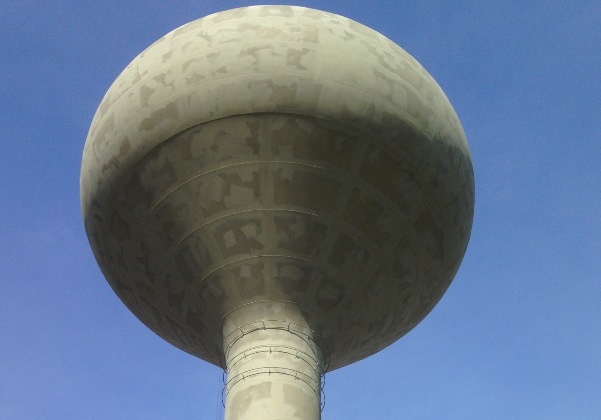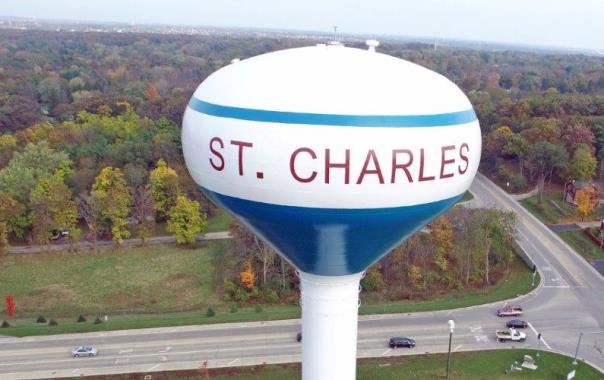About 40 miles (64.4 km) west of Chicago lies a riverfront town called St. Charles, Illinois. The Fox River, which cuts through the heart of the downtown area, has given the town not only an area for boating festivals, dragon boats, and other water sports, but also a mascot. So when a new potable water tank was being built for the residents of St. Charles, it was decided that the tank would showcase the town name and its symbol.
Determining who got to see the name versus the fox logo, though, wasn’t quite as easy to decide. “It took a long time to get the city to approve it,” Bill Pegel said of the strategy of tank’s exterior. Pegel was project manager for the four-person crew from CB&I that was in charge of erecting and coating the 1,500,000-gallon (5,678.1 m³) tank. “Because of the location to the neighborhood they were really going back and forth on the orientation: what faced what direction,” he said. “The fox faces the neighborhood and the letters face the main street there.”
“The fox is a big deal main part of the city logo and built near Fox River,” Pegel continued. It was a priority, but first they had to create the backdrop.
Blast Off!
It took the CB&I crew 12 weeks to build the elevated tank with grade A36 steel. Then, they had to paint it. “We try to paint as many of our tanks as we can,” Pegel explained. On this project, that included prepping and coating the tank interior that would hold the water, the tank interior that would stay dry, the entire exterior, and the specially designed logo. Those would cover 22,500 square feet (2,090.3 m²), 11,400 square feet (1,059.1 m²), 26,800 square feet (2,489.8 m²), and 2,240 square feet (208.1 m²), respectively.
One stage that the crew didn’t need to worry about was priming; it was completed in the shop before the project started. The primer was spray applied to achieve a thickness of 2.5‒3.5 mils (63.5‒88.9 microns) with Tnemec’s Hydro-Zinc. Although conditions at the shop were easily controlled, that wasn’t the case onsite, so all other coats had to be applied by brush and roller to avoid overspray.
Onsite painting also meant working near a neighborhood and intersection. At first, they thought they’d need to use containment to avoid contamination during the prep stage, but then the crew decided to give their new vapor blaster a go.
“To the exterior, we did a vapor blast, which was new to this job for us,” Pegel explained. “We did it because in that neighborhood after the inspection we were concerned about blast media getting onto cars and homes in the area, and we were trying to keep complaints down. Vapor blast pretty much drops right to the ground or is caught by the machine.”

The crew blasted the raw edges that were welded onsite to achieve a NACE No. 3/Society for Protective Coatings (SSPC) Surface Preparation (SP) 6: Commercial Blast Cleaning. They used a unit from Graco called the EcoQuip 2, alluvial garnet for the media (supplied by Blast-One), and HOLD*BLAST by CHLOR*RID. “It worked really well for us. It sped up the process and we didn’t have any complaints from our neighboring homes or cars driving by. Also the site stayed pretty clean,” Pegel said. Any spent materials that dropped to the ground were then vacuumed up and disposed of properly.
In addition to the typical personal protective equipment (PPE) used on the job, the crew also wore supplied-air blast hoods from RPB with Grade D breathable air while blasting. The typical PPE included hard hats, glasses, ear plugs, gloves, and work boots. “Safety considerations were numerous; executing the work safely is always CB&I’s top priority,” Pegel said.
When working at heights on the exterior of the tank, the crew used stages from Spider, which included custom-designed personal fall arrest systems, according to Pegel. And when working on the inside of the tank, they used a New England boom, which is a ladder with a trolley on it. Also on the interior, the crew used blast pots by Axxiom Manufacturing to dry blast to NACE No. 2/SSPC-SP-10: Near-White Blast Cleaning.
System Strategy
The painting portion of the project took about 10 weeks to complete. Erecting the tank pushed the crew into winter 2015, which meant that they were painting in the spring of the following year. “We try to use as much of the painting season as we can,” Pegel explained. “We get so much wind, water, rain, condensation on the tank, we have to use as many workable hours as we can.” On this project, they worked 10- to 12-hour days, seven days a week, depending on the weather.
When they were able to use the daylight, the CB&I crew got to work on the three-coat systems — different for each area.
“We usually do the base, or bell, up, but this one we did from the top down because of the darker color on the band,” Pegel explained. “On this one, we had two bands that were dark/teal green so we basically did the white Hydro from the top down to the lower knuckle,” he continued. “With the green stripe, we had to get that done before we did the shaft to avoid drip.” They also worked outside in.
To the outside, they applied the intermediate coat, Endura-Shield at 2‒3 mils (50.8‒76.2 microns) followed by a coat of HydroFlon at 2‒3 mils (50.8‒76.2 microns). The system reached 8.5‒11.5 mils (215.9‒202.1 microns) with the logo.
To the inside of the bell, they applied the intermediate coat followed by two layers of the topcoat. The layers went beige followed by white “so that we can see the differences between the tank coats,” Pegel said. The overall thickness of that system was 10.5‒15.5 mils (266.7‒393.7 microns) DFT — a little bit thicker due to that extra topcoat.
To the interior dry area, the system was the same as the exterior — one coat each of the intermediate and top coats — but with a white layer followed by a beige layer. Also without the additional thickness from the logos, the overall system here reached a total of 6.5‒9.5 mils (165.1‒241.3 microns).
Homegrown Tank
“This is an all Illinois crew doing an all Illinois tank. Typically our guys go all over, so this was nice — close to home,” Pegel explained.
The logo was another local treat. The CB&I crew used the weld seams as the guides for the teal borders, rolling and brushing the blue coating around the brown “St. Charles” lettering. Templates helped them get the letters and foxes right.
And with the last coat on, the project, which won first place in Steel Tank Institute Steel Plate Fabricators Association (STI-SPFA)’s 2016 Annual Product Awards for Elevated Tank, was complete and the town of St. Charles was left with one foxy tank!
